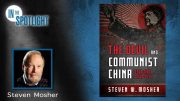Many Americans still scoff at the idea of a conspiratorial interpretation of ongoing events. The Shadows of Power by James Perloff demonstrates that they scoff at their own peril. By sheer weight of evidence, and perhaps more clearly than ever before, this account overwhelms any and all arguments of the disbelievers. Piling fact upon fact, the author moves unerringly to the frightening conclusion that we are being manipulated into a merger with the Soviet bloc and a New World Order.
Although not by any means the first exposé of the “invisible government” directed by David Rockefeller’s Council on Foreign Relations, this book is an invaluable summary and updating of this vital subject. However, it must not be imagined that this is a giant tome to be waded through. On the contrary, it is a definitive volume of 264 pages, including numerous photographs.
Conspiracy Simplified
Although voluminous literature on the CFR and its purposes exists, Perloff shows an extraordinary talent for boiling it down to essentials. He presents the conspiracy simplified. He selects his points with care and sticks to them; there are no digressions. His style is lean, almost minimal, and his tone dispassionate. The result is a book of great clarity and power that is impossible to put down once begun.
To add to its merits, this book is for everyone, no matter how knowledgeable one is about the subject. For beginners, it is an introduction par excellence. For the better informed, there is new material gleaned from the author’s extensive study of Foreign Affairs, the CFR’s own publication. Above all, for those who have long followed the conspiratorial designs of the CFR, there are many gems of clarification about familiar episodes that fill in missing links and make the picture whole.
In orderly fashion, The Shadows of Power begins with the origins and formation of the Council in the first decades of this century. It then takes us behind the scenes in the administrations of every President from Franklin Roosevelt to Ronald Reagan, showing how each used, or was used by, the inner circle of elites in the CFR. The book also discusses the Great Depression, the media, the two World Wars, the Korean War, and the Vietnam War. It brings us up to date on the latest moves by the CFR and on what to expect in the near future. In retrospect, it is astonishing that Perloff covers so much ground in so few pages. Although he ends on a note of hope for turning things around, overall the book bears witness to our own folly in allowing this handful of power-crazed men to acquire such extensive control over our lives during the past 60 years.
If you are mystified as to the identities of the players in this game of deceit, Perloff names them all — Presidents, Cabinet heads, State Department officials, international bankers, the “best” families, media bigwigs, businessmen, military officers, and politicians of every stripe. We are not left in doubt as to who did what. The “powers behind the throne” are clearly depicted.
Hypocrisy Exposed
The author tells us that the CFR has two overriding characteristics: one is pro-Communism both at home and abroad; the other is a steady drive toward abolition of our national sovereignty. Both of these thrusts are, of course, rhetorically denied, while Insider publications and policy decisions prove the opposite. Thus, we should not be surprised that Ronald Reagan speaks convincingly against Communism yet allows freedom fighters to be overcome in Nicaragua, Angola, Mozambique, and Afghanistan; moves against South Africa (under Communist attack); destabilizes the Philippines (also under Communist attack); increases trade and credits to the Soviet bloc and Communist China; and disarms the West through unenforceable treaties.
Domestically, too, CFR machinations often seem to be at the opposite end of the spectrum from the “Establishment.” Perloff relates a particularly damning and enlightening incident involving a 1968 Students for a Democratic Society (SDS) Convention, at which radical student revolutionaries were approached by some of the world’s leading industrialists from the Business International Roundtables. These businessmen offered to finance SDS demonstrations in Chicago, and to donate Rockefeller money outright. They also asked the group to make a lot of radical commotion so that the Business Roundtables could appear to be in the center as they actually moved left.
It must not be assumed that this kind of support for Communism means that CFR members are Communist; they are not. The author makes it clear that Communism is being used to consolidate the world for the more important of the two thrusts — the demise of our national government and its replacement by a one-world government that must necessarily include convergence with the Communist bloc. Perloff points out that numerous CFR members highly placed in government have openly advocated this amazing position. Walt Rostow, chairman of the State Department’s policy planning council and National Security Advisor under Kennedy and Johnson, put it plainly when he wrote (before his appointments):
It is a legitimate American national objective to see removed from all nations — including the United States — the right to use substantial military force to pursue their own interests. Since this residual right is the root of national sovereignty and the basis for the existence of an international arena of power, it is, therefore, an American interest to see an end to nationhood as it has been historically defined.
Henry Kissinger and Zbigniew Brzezinski, two immigrants who derive their power from Nelson (now deceased) and David Rockefeller respectively, are outspoken proponents of world government. In his book Between Two Ages, Brzezinski declared that “National sovereignty is no longer a viable concept,” and that
Marxism represents a further vital and creative stage in the maturing of man’s universal vision. Marxism is … a victory of reason over belief.
It is little remembered now that, in the 1950s, the CFR’s Atlantic Union — then the primary front group for world government — brought several resolutions before Congress that would have authorized a convention to lay the foundation for a political union of the United States and Europe. Although that attempt was premature and failed, we are now witnessing the economic and political consolidation of Europe in the Common Market and European Parliament.
Now called “globalism,” the concept of world government is being taught in almost every classroom in the nation under the pleasing rubrics of “international brotherhood” and “world peace.”
Perloff explains that, once these main propositions of the CFR are understood, everything else falls into place. We can understand how Richard Nixon almost accidentally fell into his meteoric career (six years from obscurity to the White House) when he happened to run for Congress against Congressman Jerry Voorhis (D-Calif.), who had introduced a bill calling for the dissolution of the Federal Reserve System, the cornerstone of Insider financial control. Nixon was immediately taken on and financed by the New York bankers. We can see why Senator Joseph McCarthy was destroyed, not for exposing Communists but for getting too close to exposing the Insiders. We can understand Eisenhower’s logic in allowing the Hungarian freedom fighters to perish in order to break the spirit of rebellion in Eastern Europe. Events that formerly made no sense suddenly become clear. No longer do we need to be deceived by official sophisms such as: “Friendly nations along the Soviet Union’s borders are necessary for world peace”; or, in the case of Kennedy’s cancellation of vital air strikes at the Bay of Pigs, “too much U.S. involvement might adversely affect world opinion.”
The Shadows of Power is especially enlightening about the four wars into which we have been maneuvered in this century. In both World Wars, an electrifying incident was created: in 1915, the sinking of the Lusitania; in 1941, Pearl Harbor. The dual purpose of the Insiders in both wars was to advance Communism and set the stage for world government. In 1919 the League of Nations was premature, but in 1945 the globalists succeeded in setting up a permanent framework — the United Nations.
So, too, the Korean War embraced a number of important CFR world-government objectives: undeclared war (removed the constitutional authority of Congress); restrictions on the military; a no-win posture (victory was not the object); and United Nations auspices. In fact, Dean Acheson declared that the only reason we fought in Korea was to validate the UN and accredit its police powers. This was echoed by a CFR writer who said, “We have made historic progress toward the establishment of a viable system of collective security.” What bitter reading for those who lost husbands or sons in this manipulated conflict!
The revelations in Perloff’s book seem endless: why $13 billion was spent on the Marshall Plan; how the CFR controls both major political parties; the purpose of the Trilateral Commission; how “undesirable” congressmen and governors are eliminated; how and why Lyndon Johnson was “dumped”; what My Lai was for; what was behind Watergate.
There is a question of how the Insiders plan to maintain long-term control over the Soviet monster they have created. All indications are that the CFR presently controls — or thinks it controls — the Soviets through capital and technology; otherwise, we would be seeing a reversal of its pro-Communist policy. It is plain, especially since Gorbachev’s advent, that we are headed for a coalition government; yet Perloff says that coalition governments have always ended up under Communist control. If it is true that the Soviets have been allowed to develop a nuclear arsenal far superior to ours and have an ABM shield in place while we have none, a coalition government would be short-lived. Yet it is scarcely credible that the Insiders can be planning their own demise. Is there a missing ingredient here? Or are the ruthless Insiders being sucked in by the Soviets?
Our Primary Weapon
Whatever the answer, it would hardly matter who was our master once such a world government was put into place. The lesson to be learned from Perloff’s book is that this nightmare need not take place if each one of us works to prevent it. Knowledge is our primary weapon. We must understand that we are facing a criminal conspiracy that is not headquartered in Moscow or Peking but in Washington and New York; this is the key to understanding everything else. Without identifying the enemy, we can never win the war. In spite of media disinformation and cover-up, there is nothing mysterious or obscure about what is going on, thanks to comprehensive literature telling the truth; much of it, like this book, has been published by Western Islands, an affiliate of The John Birch Society.
Although time has proven the Society right on every count, do not expect to see The Shadows of Power on the New York Times bestseller list. The Times would not want you to know that this is the one book every American should read and act upon.



